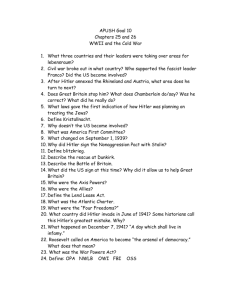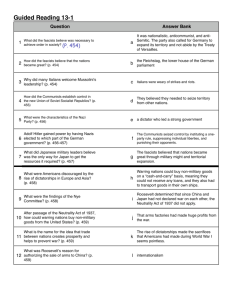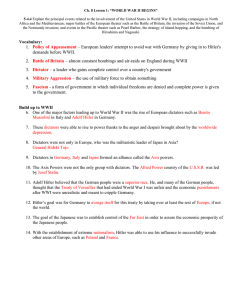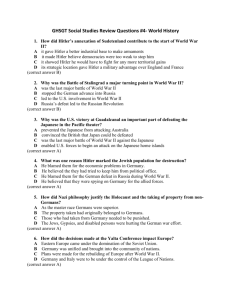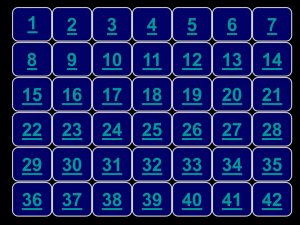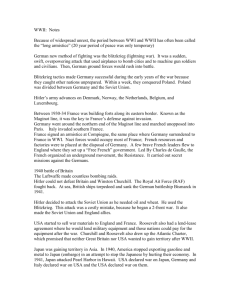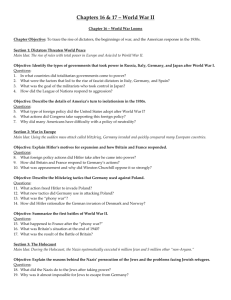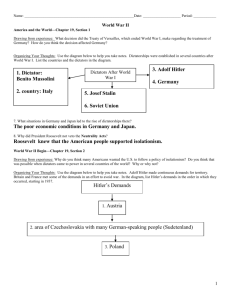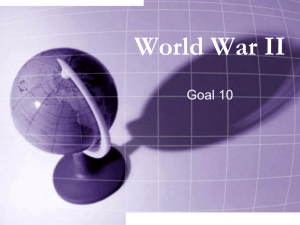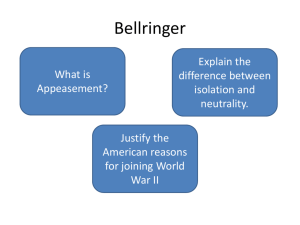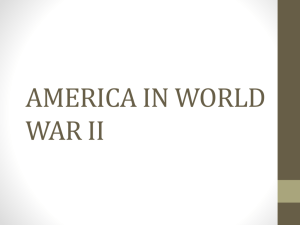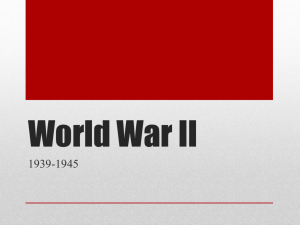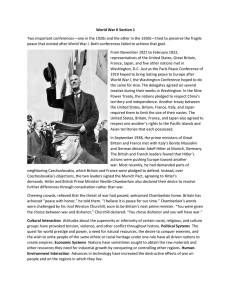Chapter 19 and 20 Test Review
advertisement
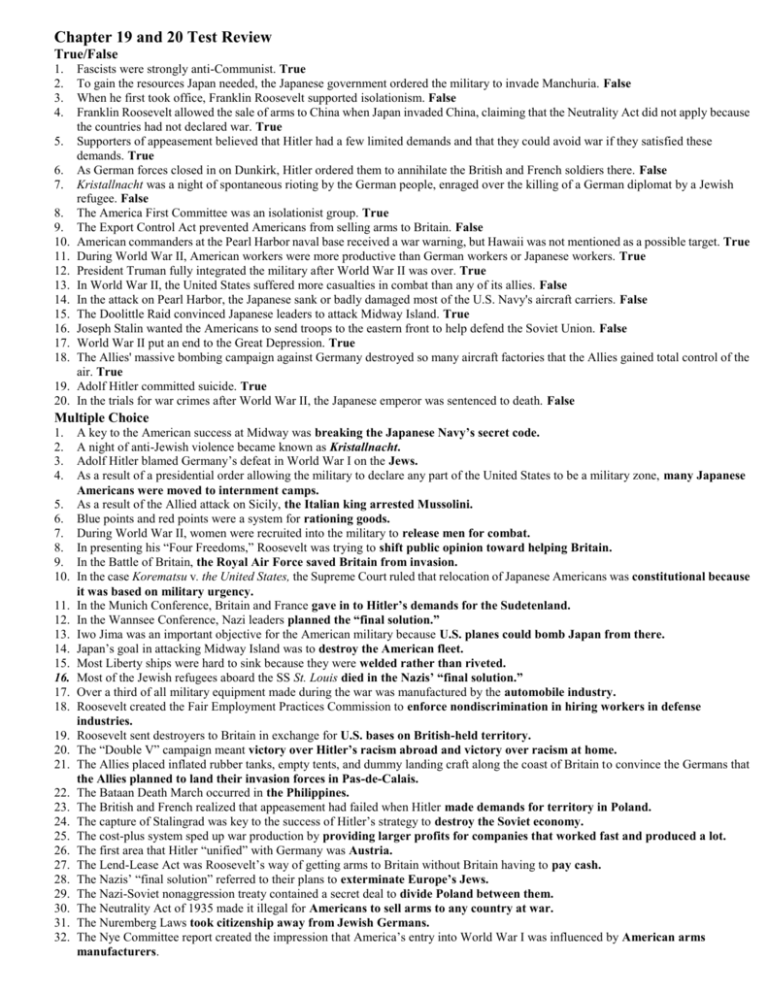
Chapter 19 and 20 Test Review True/False 1. 2. 3. 4. 5. 6. 7. 8. 9. 10. 11. 12. 13. 14. 15. 16. 17. 18. 19. 20. Fascists were strongly anti-Communist. True To gain the resources Japan needed, the Japanese government ordered the military to invade Manchuria. False When he first took office, Franklin Roosevelt supported isolationism. False Franklin Roosevelt allowed the sale of arms to China when Japan invaded China, claiming that the Neutrality Act did not apply because the countries had not declared war. True Supporters of appeasement believed that Hitler had a few limited demands and that they could avoid war if they satisfied these demands. True As German forces closed in on Dunkirk, Hitler ordered them to annihilate the British and French soldiers there. False Kristallnacht was a night of spontaneous rioting by the German people, enraged over the killing of a German diplomat by a Jewish refugee. False The America First Committee was an isolationist group. True The Export Control Act prevented Americans from selling arms to Britain. False American commanders at the Pearl Harbor naval base received a war warning, but Hawaii was not mentioned as a possible target. True During World War II, American workers were more productive than German workers or Japanese workers. True President Truman fully integrated the military after World War II was over. True In World War II, the United States suffered more casualties in combat than any of its allies. False In the attack on Pearl Harbor, the Japanese sank or badly damaged most of the U.S. Navy's aircraft carriers. False The Doolittle Raid convinced Japanese leaders to attack Midway Island. True Joseph Stalin wanted the Americans to send troops to the eastern front to help defend the Soviet Union. False World War II put an end to the Great Depression. True The Allies' massive bombing campaign against Germany destroyed so many aircraft factories that the Allies gained total control of the air. True Adolf Hitler committed suicide. True In the trials for war crimes after World War II, the Japanese emperor was sentenced to death. False Multiple Choice 1. 2. 3. 4. 5. 6. 7. 8. 9. 10. 11. 12. 13. 14. 15. 16. 17. 18. 19. 20. 21. 22. 23. 24. 25. 26. 27. 28. 29. 30. 31. 32. A key to the American success at Midway was breaking the Japanese Navy’s secret code. A night of anti-Jewish violence became known as Kristallnacht. Adolf Hitler blamed Germany’s defeat in World War I on the Jews. As a result of a presidential order allowing the military to declare any part of the United States to be a military zone, many Japanese Americans were moved to internment camps. As a result of the Allied attack on Sicily, the Italian king arrested Mussolini. Blue points and red points were a system for rationing goods. During World War II, women were recruited into the military to release men for combat. In presenting his “Four Freedoms,” Roosevelt was trying to shift public opinion toward helping Britain. In the Battle of Britain, the Royal Air Force saved Britain from invasion. In the case Korematsu v. the United States, the Supreme Court ruled that relocation of Japanese Americans was constitutional because it was based on military urgency. In the Munich Conference, Britain and France gave in to Hitler’s demands for the Sudetenland. In the Wannsee Conference, Nazi leaders planned the “final solution.” Iwo Jima was an important objective for the American military because U.S. planes could bomb Japan from there. Japan’s goal in attacking Midway Island was to destroy the American fleet. Most Liberty ships were hard to sink because they were welded rather than riveted. Most of the Jewish refugees aboard the SS St. Louis died in the Nazis’ “final solution.” Over a third of all military equipment made during the war was manufactured by the automobile industry. Roosevelt created the Fair Employment Practices Commission to enforce nondiscrimination in hiring workers in defense industries. Roosevelt sent destroyers to Britain in exchange for U.S. bases on British-held territory. The “Double V” campaign meant victory over Hitler’s racism abroad and victory over racism at home. The Allies placed inflated rubber tanks, empty tents, and dummy landing craft along the coast of Britain to convince the Germans that the Allies planned to land their invasion forces in Pas-de-Calais. The Bataan Death March occurred in the Philippines. The British and French realized that appeasement had failed when Hitler made demands for territory in Poland. The capture of Stalingrad was key to the success of Hitler’s strategy to destroy the Soviet economy. The cost-plus system sped up war production by providing larger profits for companies that worked fast and produced a lot. The first area that Hitler “unified” with Germany was Austria. The Lend-Lease Act was Roosevelt’s way of getting arms to Britain without Britain having to pay cash. The Nazis’ “final solution” referred to their plans to exterminate Europe’s Jews. The Nazi-Soviet nonaggression treaty contained a secret deal to divide Poland between them. The Neutrality Act of 1935 made it illegal for Americans to sell arms to any country at war. The Nuremberg Laws took citizenship away from Jewish Germans. The Nye Committee report created the impression that America’s entry into World War I was influenced by American arms manufacturers. 33. The U.S. Marines had severe casualties at Tarawa in part because the shallow reef prevented many landing craft from reaching shore. 34. The United States caused massive fires in Tokyo by dropping bombs filled with napalm. 35. To get resources, the Japanese military invaded Manchuria. 36. Which choice best completes the diagram? Japan Matching 1. 2. 3. 4. 5. 6. 7. 8. 9. 10. 11. 12. 13. 14. 15. 16. 17. 18. 19. 20. African American military unit Tuskegee Airmen beginning of Operation Overlord D-Day believed by Hitler to be a “master race” destined to rule the world Aryans bomber that dropped the first atomic bomb Enola Gay commander of the United States Navy in the Pacific Chester Nimitz first time American troops had to fight the German army in North Africa Kasserine Pass Hitler’s autobiography Mein Kampf idea that trade between nations helps to prevent war internationalism in overall command of the invasion of France Dwight D. Eisenhower led the American team of engineers and scientists building the atomic bomb Robert Oppenheimer led the troops that rescued the Americans trapped at Bastogne George Patton limit availability of consumer products ration living space lebensraum mass killing of millions of European Jews by the Nazis Holocaust Nazi extermination camp Auschwitz Nazi government secret police Gestapo one of the first and largest Nazi concentration camps Buchenwald requirement imposed by the Neutrality Act for the purchase of nonmilitary supplies from the United States cash and carry unification Anschluss upon evacuating the Philippines, said “I shall return” Douglas MacArthur
